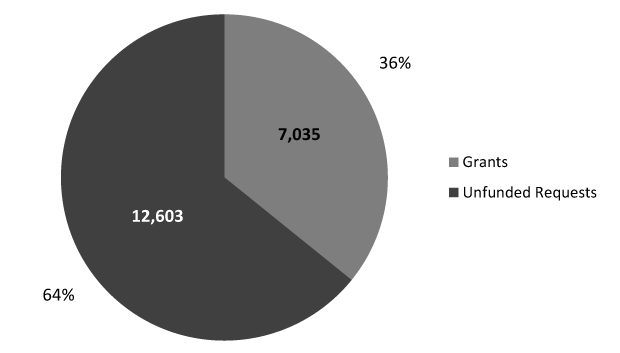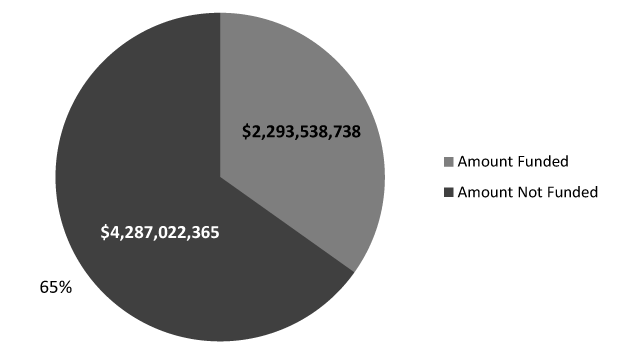The Continuing Demand for 21st Century Community Learning Centers Across America: More Than Four Billion Dollars of Unmet Need
The America After 3PM study determined that of the 14.3 million children in self-care after school, nearly 4 million of them would like to participate in an afterschool program if one were available to them in their community (Afterschool Alliance, 2003). In a more recent study, it was determined that the number of students in self-care rose from 14.3 million in 2003 to 15.1 million in 2009, despite greater availability of afterschool care (Afterschool Alliance, 2009). This disparity prompted a study to determine to what extent the largest nationwide funding source for local afterschool and summer learning programs in, or linked to, schools is meeting the demand for requests.
This potential funding source is the federal 21st Century Community Learning Centers initiative. The 21st Century Community Learning Centers initiative, funded by the United States Department of Education, supports community learning centers that provide academic enrichment opportunities during nonschool hours for children, particularly students who attend high-poverty and low-performing schools (U.S. Department of Education, n.d.).
Although it is a federally financed program, state departments of education manage the actual competition for funding in their states. Awards are made to local schools or community groups (working with local schools) interested in offering educational, youth development, and family programming afterschool and during summers. Interestingly, the 21st Century Community Learning Centers initiative is the largest federally funded education effort that fosters both community-school partnerships and family involvement.
Because this is such a large and diverse country with many different, and often competing, education interests in the various states and localities, there is a strong need to assess over time the extent of the demand for afterschool and summer learning opportunities funded by 21st Century Community Learning Centers.
Because this is such a large and diverse country with many different, and often competing, education interests in the various states and localities, there is a strong need to assess over time the extent of the demand for afterschool and summer learning opportunities funded by 21st Century Community Learning Centers. So the purpose of this study was to assess the extent to which state competitions for 21st Century Community Learning Centers were able to meet local requests for funding over the past 9 years. Of particular interest were both the percentage of grant requests that were funded and the total dollar amount of requests funded over these years.
Methodology
In order to determine the number of grant applications and recipients for the 21st Century Community Learning Centers program, the online database from the U.S. Department of Education’s Profile and Performance Information Collection System (PPICS) was searched. Queries were conducted by competition, by state, from 2002 to 2010 by year for each year listed below. Therefore, the data reported here are as accurate as the data held by the PPICS. These queries were conducted October–November, 2011.
Results
- Between 2002 and 2010, only about one in three applicants for 21st Century Community Learning Centers was awarded funding (See Table 1 and Figure 1). During this time period 19,638 grant requests were received by 21st Century, of which 7,034 were funded (35.82%).
- Between 2002 and 2010, nearly $4.3 billion of total requests for 21st Century Community Learning Center programming were not funded (see Table 2 and Figure 2). During that same time period, over $6.5 billion was requested from 21st Century funding, of which nearly $2.3 billion (34.85%) was received.
Figure 1 displays the total number of awards requested and received each year between 2002 and 2010. Figure 2 displays the total amount of money requested and received during the same time period.
Table 1. 21st Century grant number of applications and awards, 2002–2010.1
| Year | Applicants | Awards | Percent Awarded |
|---|---|---|---|
| 2002 | 474 | 140 | 29.54% |
| 2003 | 2,836 | 775 | 27.33% |
| 2004 | 3,498 | 1,389 | 39.71% |
| 2005 | 1,397 | 464 | 33.21% |
| 2006 | 1,293 | 328 | 25.37% |
| 2007 | 2,379 | 895 | 37.62% |
| 2008 | 2,510 | 1,063 | 42.35% |
| 2009 | 3,095 | 1,234 | 39.87% |
| 2010 | 2,156 | 746 | 34.60% |
| TOTAL | 19,638 | 7,034 | 35.82% |
Table 2. 21st Century grant application dollar amount requested versus received, 2002–2010.2
| Year | Money Requested | Money Granted | Percent Granted |
|---|---|---|---|
| 2002 | $149,577,283 | $33,879,393 | 22.65% |
| 2003 | $902,930,300 | $238,297,883 | 26.39% |
| 2004 | $1,267,895,855 | $480,515,709 | 37.90% |
| 2005 | $391,072,195 | $97,937,098 | 25.04% |
| 2006 | $405,828,894 | $84,254,758 | 20.76% |
| 2007 | $815,515,985 | $298,568,650 | 36.61% |
| 2008 | $994,112,531 | $454,767,845 | 45.75% |
| 2009 | $1,100,341,496 | $392,087,341 | 35.63% |
| 2010 | $553,286,565 | $213,230,061 | 38.54% |
| TOTAL | $6,580,561,103 | $2,293,538,738 | 34.85% |
Figure 1. 21st Century grant total number of grants and unfunded requests, 2002–2010

Figure 2. 21st Century grant total amount requested and received, 2002–2010

Conclusion
Looking across the states over 9 recent years, it is clear that the interest and demand has been high and remains steady for 21st Century Community Learning Centers.
On average, only about one in three grant applications receive funding. From 2002 to 2010, there were over $4 billion dollars of unfunded 21st Century Community Learning Center applications across America.
This high demand and percentage of unfunded applications should not be surprising when compared to the two national surveys conducted during this same time period, which showed a high interest by families for more quality afterschool programs across America.
Given the continuing high interest and demand for 21st Century Community Learning Centers, it would make sense to find ways to increase significantly the support and resources for school-community partnerships that expand learning after school and during the summer across America.
Footnotes
- The data presented here are part of the Profile and Performance Information Collection System (PPICS) http://ppics.learningpt.org/ppicsnet/public/default.aspx. According to the PPICS website, “The purpose of this system is to collect basic information about 21st CCLC programs across the United States. PPICS was created in 2003 at the commission of the US Department of Education (ED). The system was built to help ED track 21st CCLC programming following the transition from federal to state administration, which took place in 2001. Each year, PPICS is used to collect program data from some 3,000 21st CCLC grants covering close to 9,000 centers serving 1.5 million student attendees.” ↩
- Ibid. ↩
References
Afterschool Alliance. (2009). America after 3PM: Key findings. Retrieved from http://www.afterschoolalliance.org/documents/AA3PM_Key_Findings_2009.pdf
Afterschool Alliance. (2003). America after 3PM: A household survey on afterschool in America [Executive summary]. Retrieved from http://www.afterschoolalliance.org/press_archives/america_3pm/Executive_...
U.S. Department of Education. (n.d.). 21st Century Community Learning Centers: Program description. Retrieved November 20, 2012, from http://www2.ed.gov/programs/21stcclc/index.html


